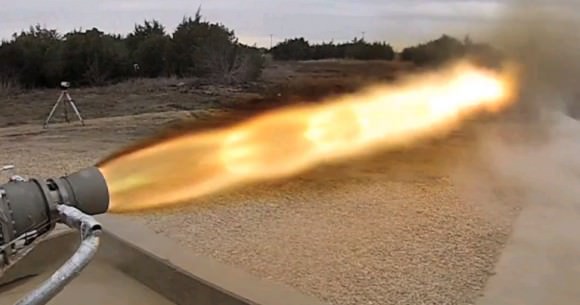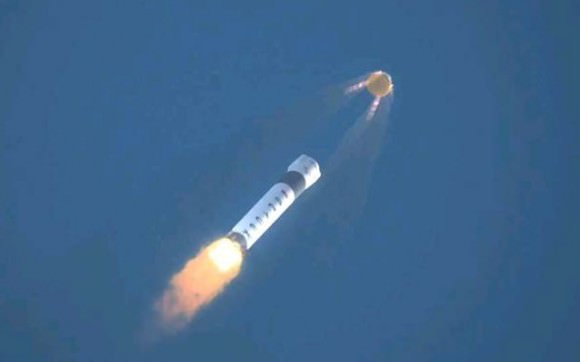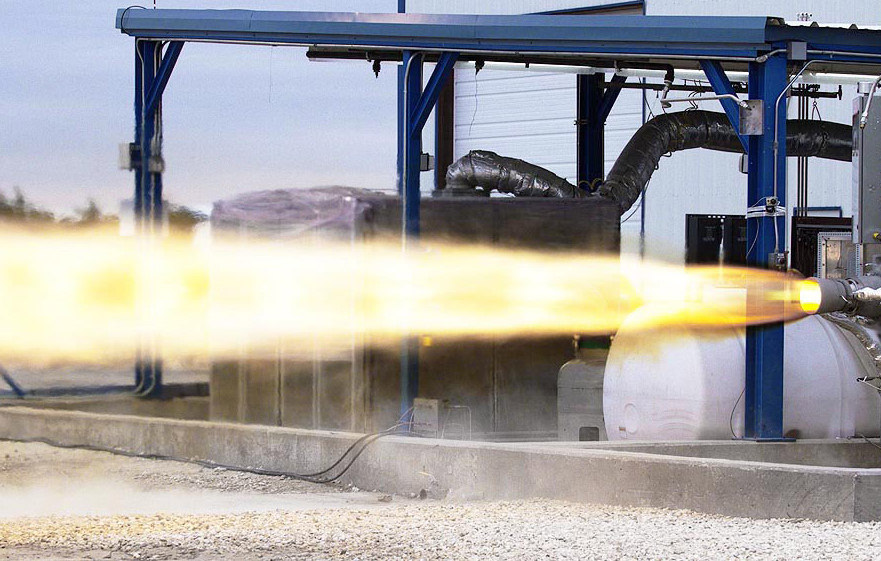[/caption]
Space Exploration Technologies (SpaceX) has test fired a prototype of its new SuperDraco engine that will be critical to saving the lives of astronauts flying aboard a manned Dragon spacecraft soaring to orbit in the event of an in-flight emergency.
The successful full-duration, full-thrust firing of the new SuperDraco engine prototype was completed at the company’s Rocket Development Facility in McGregor, Texas. The SuperDraco is a key component of the launch abort system of the Dragon spacecraft that must fire in a split second to insure crew safety during launch and the entire ascent to orbit.
The Dragon spacecraft is SpaceX’s entry into NASA’s commercial crew development program – known as CCDEV2 – that seeks to develop a commercial ‘space taxi’ to launch human crews to low Earth orbit and the International Space Station (ISS).
The engine fired for 5 seconds during the test, which is the same length of time the engines need to burn during an actual emergency abort to safely thrust the astronauts away.
Watch the SpaceX SuperDraco Engine Test Video:
Nine months ago NASA awarded $75 million to SpaceX to design and test the Dragon’s launch abort system . The SuperDraco firing was the ninth of ten milestones that are to be completed by SpaceX by around May 2012 and that were stipulated and funded by a Space Act Agreement (SAA) with NASA’s Commercial Crew Program (CCP).
“SpaceX and all our industry partners are being extremely innovative in their approaches to developing commercial transportation capabilities,” said Commercial Crew Program Manager Ed Mango in a NASA statement. “We are happy that our investment in SpaceX was met with success in the firing of its new engine.”
Dragon will launch atop the Falcon 9 rocket, also developed by SpaceX.

“Eight SuperDracos will be built into the sidewalls of the Dragon spacecraft, producing up to 120,000 pounds of axial thrust to quickly carry astronauts to safety should an emergency occur during launch,” said Elon Musk, SpaceX chief executive officer and chief technology officer in a statement. “Those engines will have the ability to deep throttle, providing astronauts with precise control and enormous power.”
“Crews will have the unprecedented ability to escape from danger at any point during the launch because the launch abort engines are integrated into the side walls of the vehicle,” Musk said. “With eight SuperDracos, if any one engine fails the abort still can be carried out successfully.”

SpaceX is one of four commercial firms working to develop a new human rated spacecraft with NASA funding. The other firms vying for a commercial crew contract are Boeing, Sierra Nevada and Blue Origin.
“SuperDraco engines represent the best of cutting edge technology,” says Musk. “These engines will power a revolutionarylaunch escape system that will make Dragon the safest spacecraft in history and enable it to land propulsively on Earth or another planet with pinpoint accuracy.”
The privately developed space taxi’s will eventually revive the capability to ferry American astronauts to and from the ISS that was totally lost when NASA’s Space Shuttle orbiters were forcibly retired before a replacement crew vehicle was ready to launch.
Because the US Congress slashed NASA’s commercial crew development funding by more than 50% -over $400 million – the first launch of a commercial space taxi is likely to be delayed several more years to about 2017. Until that time, all American astronauts must hitch a ride to the ISS aboard Russian Soyuz capsules.
This week the Russian manned space program suffered the latest in a string of failures when when technicians performing a crucial test mistakenly over pressurized and damaged the descent module of the next manned Soyuz vehicle set to fly to the ISS in late March, thereby forcing about a 45 day delay to the launch of the next manned Soyuz from Kazakhstan.


the future…. wish i had one.. loz! congratz guys!!!!
Beautiful shock diamonds in the supersonic exhaust plume. Would look great at night.
Also is this maths right? By Newton’s 2nd law and assuming the SuperDracos (SD) are angled at 45 degrees, the maximum LAS acceleration (or maximum deceleration during a propulsive landing) is…
= (8 x SD thrust x downward vector of the thrust angle) / mass of Dragon Capsule
= (8 * 67000 N * Cos 45°) / 6000 kg
= 63 m/s2 or approximately 6.4 g.
Thanks TerryG for nostalgia of physics study way back when. The angle looks less than 45, more like 30, which would increase g substantially. Seems like quite a vigorous ride! I wonder, why wouldn’t a throttle capable rocket not be computer guided? Far more accurate than a pilot under tremendous stress, I would think. Any thoughts?
I think that is for the last landing leg on non-GPS planets. Everywhere else they have proposed to use the Dracos – abort, orbital extraction (those or the steering Dracos?), ballistic descent control and braking maneuvers (I guess, flying S curves without rotation; again, dunno which set of Dracos) – computer control seems the best as you note.
The man-in-the-loop configs are difficult, at least for non-stable aircrafts. Pilot-induced oscillations have crashed more than one craft. In this case you run the risk of “engines up” attitude.
You must be right about the angle and the “vigorous ride” Donald.
Just read the latest SpaceX tweet stating that the 8 SDs give a combined axial thrust of 120,000 lb!
Hope the cup holders are reinforced, or the crew will be needing their own napkins. 🙂
Vigorous ride? Ya think? Your comment about throttle control is good.
Am I the first to spot the superfluous apostrophe in “taxi’s”? Woo!
Very cool though, I can’t wait to see the whole abort system in action, go go SpaceX!
I dub thee “Ivan”.
Federation here we come… But, were is the tranwarp drives?
I thought that was what drives the Republican party, they seem to like to have issues with gender?
Or did you mean transwarp engines? Then it is exit stage door left, towards the Star Trek set.
So, another of those things that SpaceX couldn’t do is done. (It is a massive upscaling, much maligned on some space blogs.)
I really, really hope they get to the ISS. Now the Soyuz acts up again, but this time it means keeping the SpaceX docking trained crew around.
GO Space X!
Cool Photo! I am being silly here, but a scatological joke involving beans comes to mind!
Actually, I think this project is good for the continued efforts in Space. Taco’s aside!